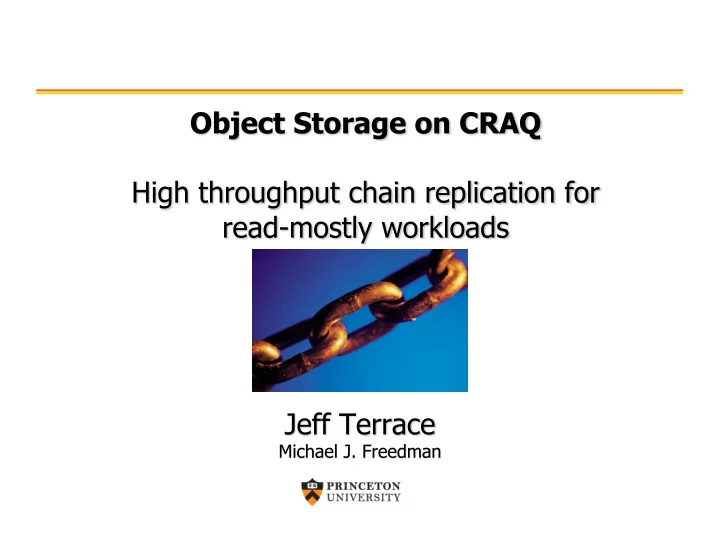

Data Storage Revolution • Relational Databases • Object Storage (put/get) Speed – Dynamo Scalability – PNUTS Availability – CouchDB Throughput – MemcacheDB No Complexity – Cassandra
Eventual Consistency Read Request Write Request Replica Replica A Manager Replica Replica B Read Request
Eventual Consistency • Writes ordered after commit • Reads can be out-of-order or stale • Easy to scale, high throughput • Difficult application programming model
Traditional Solution to Consistency Two-Phase Replica Write Request Commit: Replica 1. Prepare Manager 2. Vote: Yes 3. Commit Replica Replica 4. Ack
Strong Consistency • Reads and Writes strictly ordered • Easy programming • Expensive implementation • Doesn’t scale well
Our Goal • Easy programming • Easy to scale, high throughput
Chain Replication van Renesse & W1 W1 Schneider R1 R1 (OSDI 2004) W2 R2 R2 W2 R3 R3 Replica Write Request Read Request Replica Manager HEAD TAIL Replica Replica
Chain Replication • Strong consistency • Simple replication • Increases write throughput • Low read throughput • Can we increase throughput? • Insight: – Most applications are read-heavy (100:1)
CRAQ • Two states per object – clean and dirty Read Request Read Request Read Request Read Request Read Request HEAD Replica Replica Replica TAIL V 1 V 1 V 1 V 1 V 1
CRAQ • Two states per object – clean and dirty • If latest version is clean , return value • If dirty , contact tail for latest version number Read Request Read Request Write Request 2 1 V 2 V 1 V 1 HEAD Replica Replica Replica TAIL V 1 V 2 ,V 2 V 2 ,V 2 V 2 V 1 ,V 2 V 1 V 2 ,V 2 V 2 V 1 V 1
Multicast Optimizations • Each chain forms group • Tail multicasts ACKs HEAD Replica Replica Replica TAIL V 2 V 1 ,V 2 V 1 V 2 ,V 2 V 2 V 1 ,V 2 V 1 V 2 ,V 2 V 2
Multicast Optimizations • Each chain forms group • Tail multicasts ACKs • Head multicasts write data Write Request HEAD Replica Replica Replica TAIL V 2 ,V 3 V 2 ,V 3 V 2 ,V 3 V 2 ,V 3 V 2 V 3 ,V 3
CRAQ Benefits • From Chain Replication – Strong consistency – Simple replication – Increases write throughput • Additional Contributions – Read throughput scales : • Chain Replication with Apportioned Queries – Supports Eventual Consistency
High Diversity • Many data storage systems assume locality – Well connected, low latency • Real large applications are geo-replicated – To provide low latency – Fault tolerance (source: Data Center Knowledge)
Multi-Datacenter CRAQ DC1 HEAD TAIL DC3 Replica Replica TAIL Replica Replica Replica Replica Replica DC2
Multi-Datacenter CRAQ DC1 HEAD TAIL DC3 Replica Replica Client Replica Replica Client Replica Replica Replica DC2
Chain Configuration Motivation Solution 1. Specify chain size 1. Popular vs. scarce objects 2. List datacenters 2. Subset relevance - dc 1 , dc 2 , … dc N 3. Separate sizes 3. Datacenter diversity – dc 1 , chain_size 1 , … 4. Specify master 4. Write locality
Master Datacenter DC1 Writer HEAD TAIL Replica TAIL Replica Replica Replica DC3 Replica HEAD Replica Replica DC2
Implementation • Approximately 3,000 lines of C++ • Uses Tame extensions to SFS asynchronous I/O and RPC libraries • Network operations use Sun RPC interfaces • Uses Yahoo’s ZooKeeper for coordination
Coordination Using ZooKeeper • Stores chain metadata • Monitors/notifies about node membership DC2 DC1 CRAQ CRAQ CRAQ CRAQ ZooKeeper CRAQ ZooKeeper CRAQ ZooKeeper DC3 CRAQ CRAQ CRAQ
Evaluation • Does CRAQ scale vs. CR? • How does write rate impact performance? • Can CRAQ recover from failures ? • How does WAN effect CRAQ? • Tests use Emulab network emulation testbed
Read Throughput as Writes Increase CRAQ − 7 15000 7x- CRAQ − 3 CR − 3 10000 Reads/s 3x- 5000 1x- 0 0 20 40 60 80 100 Writes/s
Failure Recovery (Read Throughput) 60000 40000 Reads/s 20000 Length 7 Length 5 Length 3 0 0 10 20 30 40 50 Time (s)
Failure Recovery (Latency) 5000 1.5 Read Latency (ms) Write Latency (ms) 1.0 3000 0.5 1000 0.0 0 0 10 20 0 10 20 Time (s) Time (s)
Geo-replicated Read Latency 80 Mean Latency (ms) 60 40 20 CR CRAQ 0 0 5 10 15 20 Writes/s
If Single Object Put/Get Insufficient • Test-and-Set, Append, Increment – Trivial to implement – Head alone can evaluate • Multiple object transaction in same chain – Can still be performed easily – Head alone can evaluate • Multiple chains – An agreement protocol (2PC) can be used – Only heads of chains need to participate – Although degrades performance (use carefully!)
Summary • CRAQ Contributions? – Challenges trade-off of consistency vs. throughput • Provides strong consistency • Throughput scales linearly for read-mostly • Support for wide-area deployments of chains • Provides atomic operations and transactions Thank Questions? You
Recommend
More recommend